- AROUND THE SAILING WORLD
- BOAT OF THE YEAR
- Email Newsletters
- America’s Cup
- St. Petersburg
- Caribbean Championship
- Boating Safety
- Ultimate Boat Giveaway


Modernizing the International 110
- By Joe Berkeley
- April 11, 2023
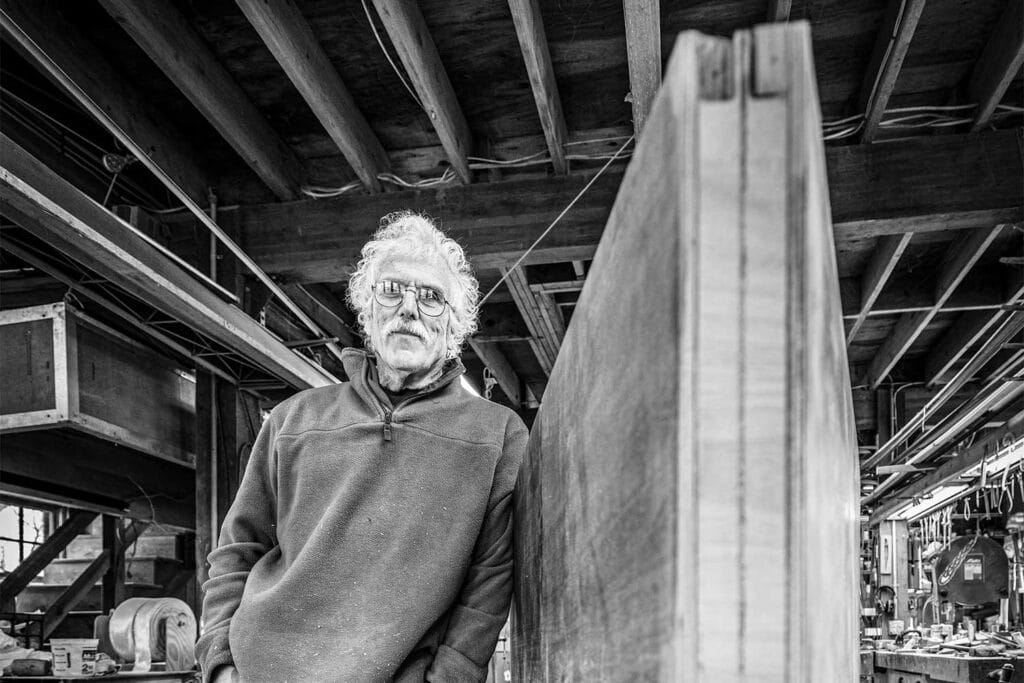
There must be something in the soil at Point Farm in Warren, Rhode Island. On this land, Steve Clark has reaped everything from traditional dories to C-class catamarans to International Canoes, and all sorts of genetically modified vessels in between. His latest crop is a brand-new International 110 crafted from sheets of mere marine plywood.
Members of the International 110 class talked about the creation of a kit boat for decades. When Clark rejoined the class, the dream became reality in short order. As the previous co-owner of Vanguard Sailboats, Clark was accustomed to building 3,000 sailboats per year. In the glory days, it took his firm about 18 hours to build a Sunfish.
Why is he putting his time and talent into building a kit for a one-design first built in 1939? With a mischievous grin, Clark says: “It’s the same reason why a dog licks his balls. Because he can.” At the age of 69, Clark is retired and still enjoys boatbuilding. He came back to the 110 because he saw it as a “geezer Canoe.”
“My competitive days in International Canoes are fewer than they used to be,” he says. “And I also wanted to be able to sail PHRF on Wednesday nights and navigation races. The 110 qualifies.”
Clark views the International 110 class as his client, and his goal is to build a quality boat that is as fast but not faster than existing boats. The first question he had to answer was what shape to make the kit boat? Clark brought in Casey Brown, who was a collaborator on previous projects, and they scanned a fiberglass International 110 built by Westease in Holland, Michigan. “The 3D scanning is remarkable,” Clark says. “Kasey set it up. The thing bounces light off the boat. We get a raw scan, then we run it through a fairing program on the computer.”
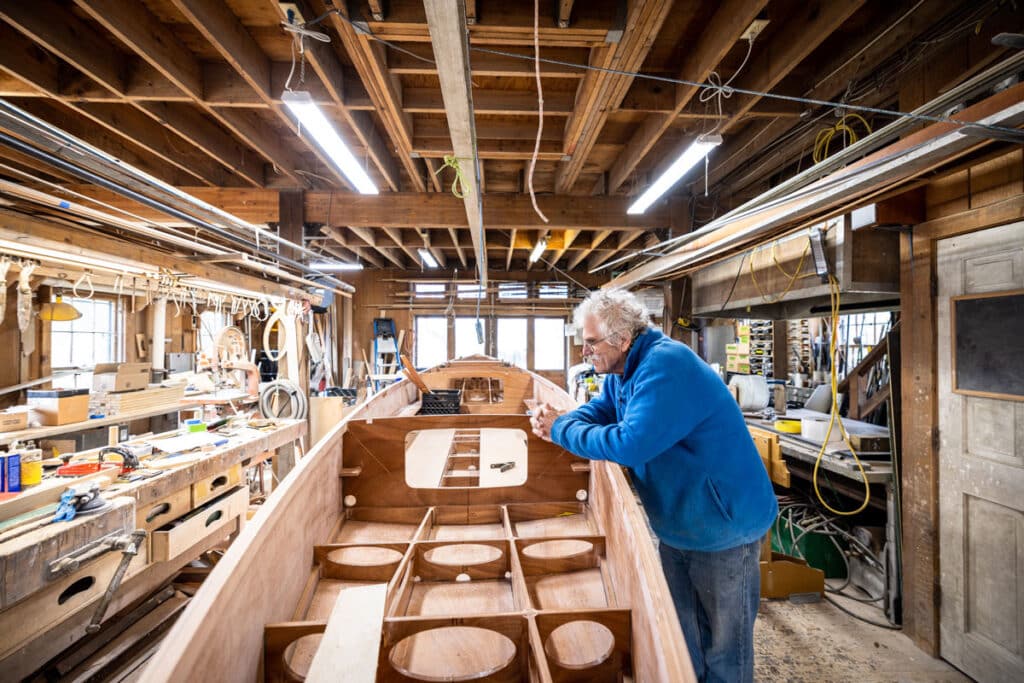
After the shape was approved by the 110 class technical chair, Clark worked on how to build the inside of the boat, spending a lot of time creating different layouts on the computer. Along the way, there were numerous obstacles to overcome. One of them was when Clark had a heart attack in June 2022. Another was the chine log. The original wooden 110s had a complicated chine that came out of a shaper. Back in the day, the builders had a large industrial machine to shape the chine. They also had a seemingly endless supply of 25-foot-long pieces of clear Douglas fir. Neither the shaper nor the stock is available.
Clark solved this challenge by treating the chine more like a stitch and glue boat. He covered the edge of the boat with a small chine, then carved a radius into it using a power plane. “It’s the same technique you use for making a round mast. You start off with a square, you cut 45-degree corners, and you sequentially facet the radius. After you’ve done that twice, you are within sandpaper of the right radius.”
Clark went through eight or nine iterations of the construction design until he was happy with the layouts. The files were prepared to be cut on a CNC machine. In the past, Clark has done the same thing with sailing canoes, noting that it is easier to ship files than big, bulky molds. “I’ve had guys in Australia build boats that I designed,” he says. “I send them a compressed file, and away it goes.”
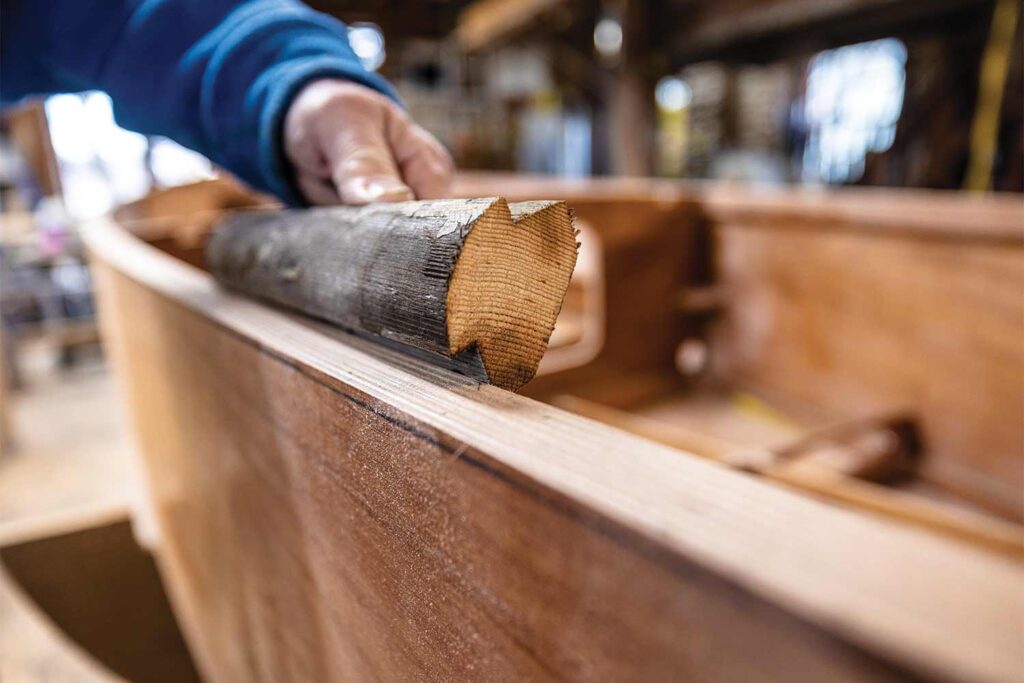
Chesapeake Light Craft cut all of the plywood to build the hull and delivered it in a flat pack for $5,600. Clark sees this technology as a game-changer. “It used to be you had to draw the boat full size on the floor, correct all the shapes. That was a week or two of lofting. Now you can do it all in computers, get the parts cut accurately, then set them up and go.”
With the assistance of fellow boatbuilder Bro Dunn, Clark believes his kit-boat International 110 will be completed by May and racing this summer. The response to the project has been positive, with many of the faithful making the pilgrimage to Clark’s barn and laying hands upon the boat. “People are excited to see a new 110 take shape. The 110 class has a large alumnae,” Clark says. “There’s a great deal of nostalgia.”
But he’s not just looking back. He has a plan for the future. Out back, Clark has seven vintage wooden 110s that could use some love. He hopes to create a program with the nearby Herreshoff Museum such that teenagers and young adults can get a boat, learn how to take care of it, then go out sailing. The talks with the museum have been positive, and there are still details to be finalized.
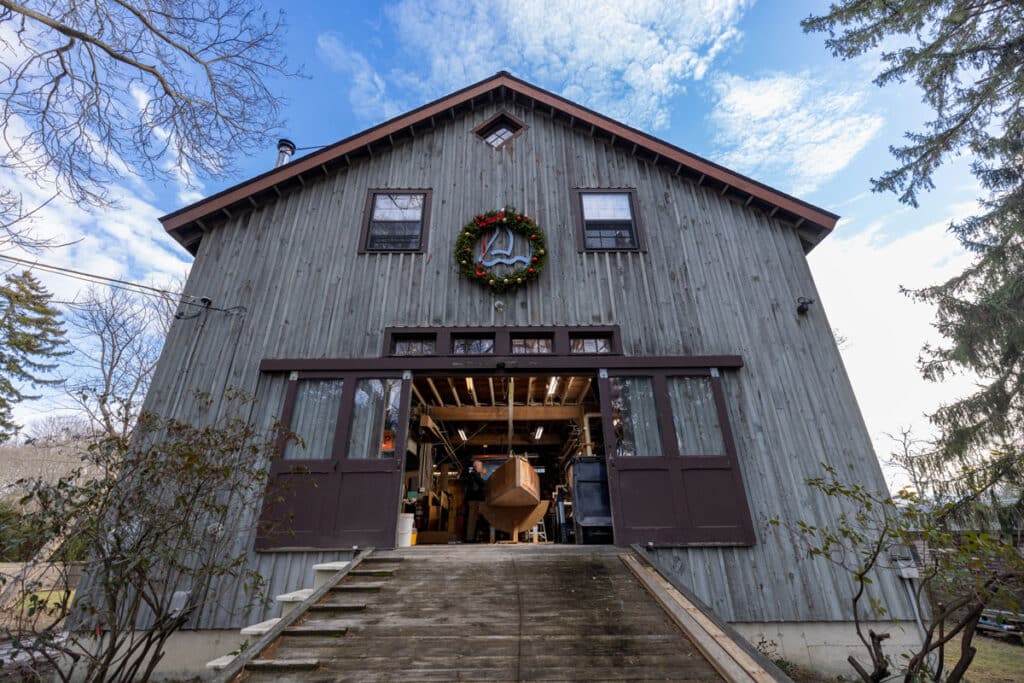
On Bainbridge Island, 3,000 miles away just west of Seattle, Fleet 19 is building a prototype 110 from a kit it developed independently of the Clark project. Its approach to 110 construction uses a combination of fiberglass-covered foam and marine plywood. Brandon Davis of Turn Point Design in Port Townsend, Washington, is deeply involved in the project. He knows his way around a build. He has worked on four America’s Cup campaigns, aerospace projects, rockets, satellites, submarines, flying cars and small-boat kits.
“The 110 has traditionally been built with a tortured plywood bottom and deck,” Davis says. “To spring the shape into the 3/8-inch plywood took quite a bit of force, requiring strong internal frames, 12 big trucker ratchet straps, boxes of screws and lots of persistence.”
To simplify the build, the Fleet 19 team chose a 100 percent recycled PET foam core because it was easier to shape. That decision meant there needed to be less internal structure, which resulted in a quicker build. There were ease of ownership considerations as well. “Most trailerable boats sit in the backyard over the winter and, if they are not tarped perfectly, will gather rainwater in their bilge. That can spell the untimely end to a plywood boat. With a foam-core International 110, you will not have to worry so much about rainwater,” Davis says.
The Seattle team’s plan is to have the first hull ready, which is already built and certified by the class measurer. They’re keen to rig it and do some testing to make sure their boat is not “unfairly fast.” Like Clark, the Seattle-area 110 sailors are drawn to the International 110 because of its simplicity. Many of them are coming from the 6 Meter yachts, which are substantially more complex and expensive than Ray Hunt’s venerable design.
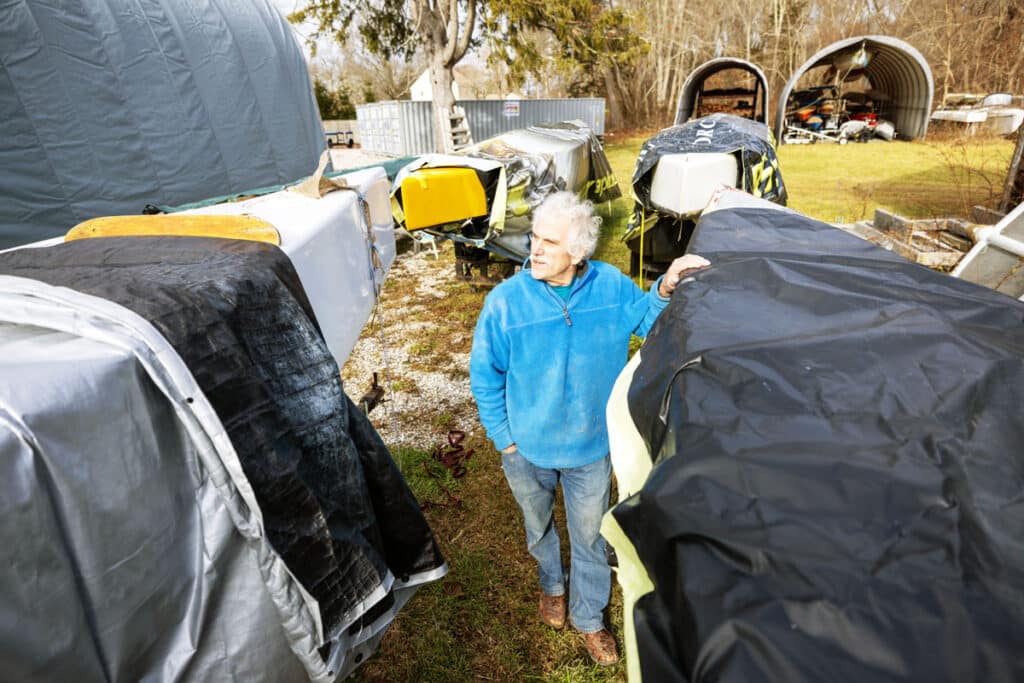
Milly Biller is the president of the 110 class, and she has rebuilt at least a dozen vintage 110s for her Inverness, California, fleet. She’s running out of old boats to repair, so she is thrilled to have new options for new sailors all over the country.
- More: one-design , Print March 2023 , Racing
- More Racing

Rivals Flush American Magic Facemask Rule Enquiry

The Reemergence of Jimmy Spithill

Running Tide Runs Swiftly Still

Mistakes And Misfires On the Final Day of Cup’s Preliminary Regatta

Emirates Team New Zealand Remain the Bullies of Barcelona

Start-Box Sparring in Barcelona on Day 2 of Preliminary Regatta

Real-time Wind Overlay Feature Added to Cup Broadcast

- Digital Edition
- Customer Service
- Privacy Policy
- Terms of Use
- Cruising World
- Sailing World
- Salt Water Sportsman
- Sport Fishing
- Wakeboarding
International 110
Class contact information.
Click below
Class Email
Class Website
One-Design Class Type: Keelboat
Was this boat built to be sailed by youth or adults? Adult
Approximately how many class members do you have? 50
Join/Renew Your Class Membership – Click here
Photo Credit:Jim Laws
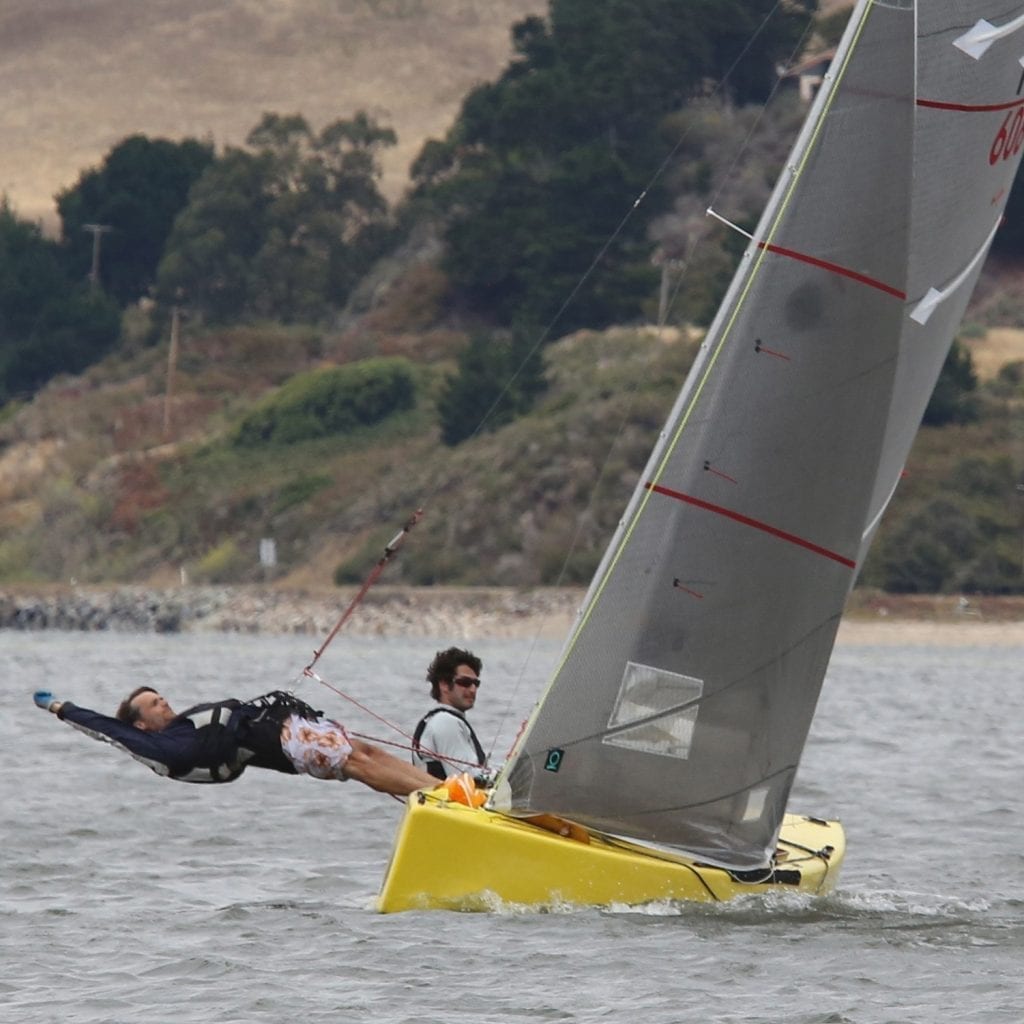
Photo Credit: Jim Laws
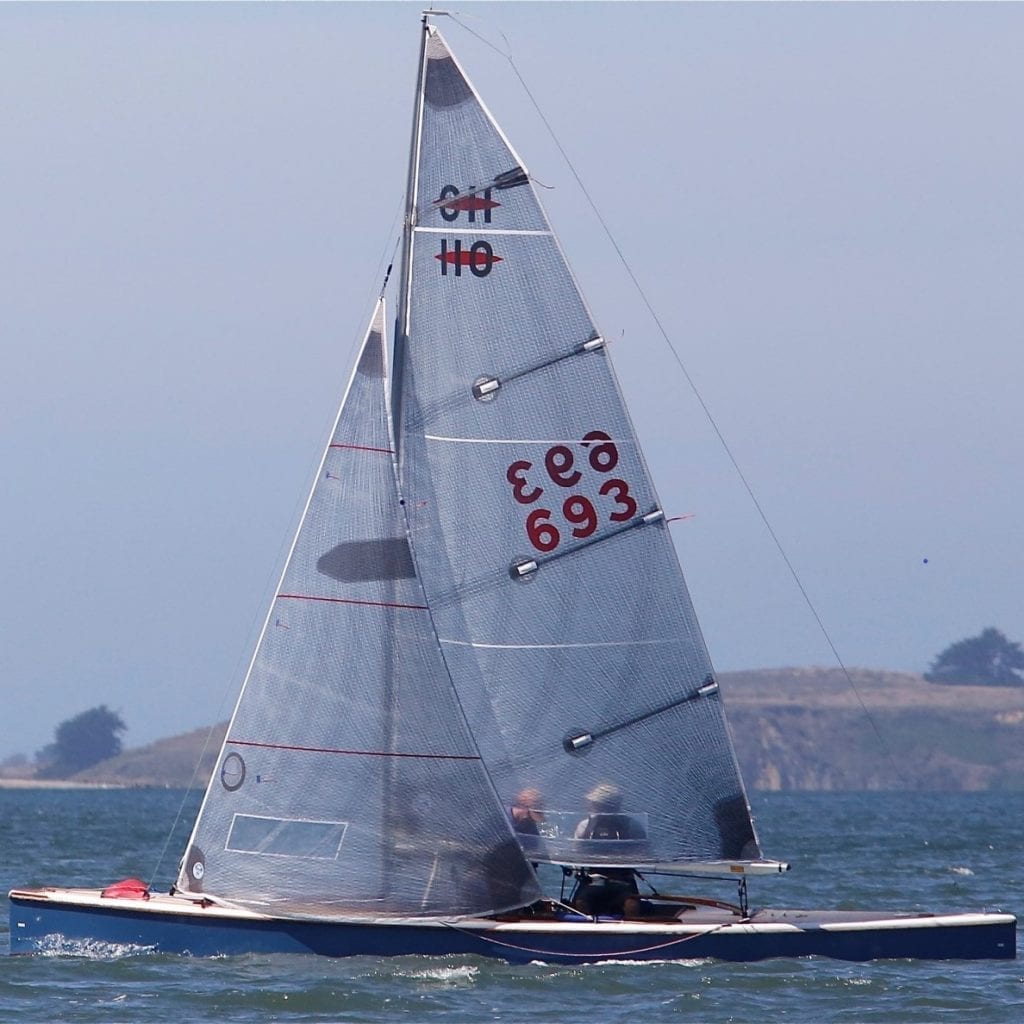
Photo Credit: Michael Sporer
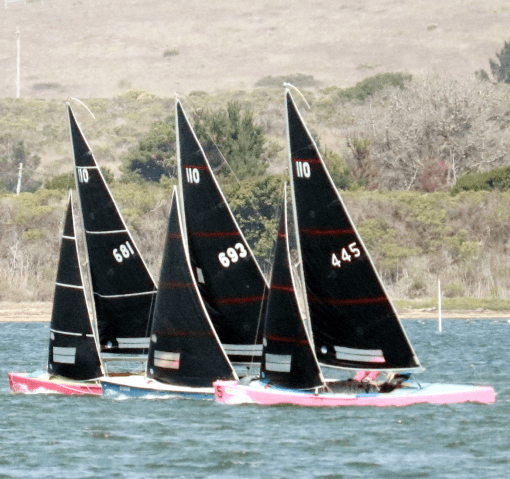
About International 110
Designed by legendary yachtsman, yacht designer and sailing Hall of Fame member C. Raymond Hunt, the International 110 is an extraordinary boat. 24′ long, 4′ wide and weighing only 910 lbs, this double-ended, flat bottomed, slab-sided planing boat is extraordinarily fun and fast in all directions. Its small sail plan, light weight, long waterline and low wetted surface make it a pleasure to sail in all wind conditions from very light to very breezy. Sailed by a crew of two, with one on the trapeze, the 110 feels and responds like a dinghy but with the stability of a keel.
Boats Produced: Approx 800
Class boat builder(s):
New Holland Marine Group 722 Park Avenue Holland, MI 49423
616-836-6847
Approximately how many boats are in the USA/North America? 75
Where is your One-Design class typically sailed in the USA? List regions of the country:
Northeast, Lake Michigan, Northern CA, Peugeot Sound
Does this class have a spinnaker or gennaker? Yes
How many people sail as a crew including the helm? 2
Ideal combined weight of range of crew: 300-350
Portsmouth Yardstick Rating: Approx 89.3
Boat Designed in 1939
Length (feet/inches): 24’0″
Beam: 4’2″
Weight of rigged boat without sails: 910
Draft: 2’9″
Mast Height: 22′
Back to One-Design Central
Copyright ©2018-2024 United States Sailing Association. All rights reserved. US Sailing is a 501(c)3 organization. Website designed & developed by Design Principles, Inc. -->

C. Raymond Hunt’s “TEN” Series (110-210-310-410-510-1010)

C. Raymond Hunt, and internationally known and respected helmsman and yacht designer. A gifted visionary, with an innate sense of the physics of motion. To his peers he was a man “ahead of his time” To his competitors, through his creation of the deep-V hull, and the radical international 110, the preeminent forefather of Hunt’s 10 series of yachts, he was feared on the race coarse.
James H. “Sham” Hunt, on his fathers 10 Series, “I have sailed on all…like the way the 110 goes through the water the best but a bit wet and pounds in a sea way…..the 510 was very quick, CRH and my mother won their share at Edgartown Regatta and the NYYC cruise. My favorite would be the 210…I am 6’2 so the 110 was very cramped for me whereas the 210 had comfort in comparison.”
For the complete biography on C. Raymond Hunt, there is the first and only biography in the works and will be offered for sale soon. Mark W. Kellogg, the author of the soon to be released Raymond Hunt biography is a long time Marbleheader, who in his youth, drove a 21-foot Huntform launch named “Cabby” as a nautical taxi, taught sailing in Hunt-designed 110s, was a paid hand on two Concordia’s, and raced with Ray Hunt in John Mooney’s Hunt-designed 5.5 Meter, “Minotaur.”
THE “ONE-TEN”

In 1936 Raymond Hunt along with engineers Bror Tamm and Gordon Munro decided to build a 36’0″ prototype at the Lawley Yard in Neponset, Masachusetts. Although there were doubts about her potential sailing abilities, she quickly proved doubters wrong. But, at the time, no one seemed to want one, the prototype was too peculiar, and slab-sided for her size.
After much thought and consideration the Raymond Hunt brain trust decided to scale down the 36′ prototype twelve feet. The new yacht was called the International 110, and with it a new era in yachting was ushered in.

After the 1938 Hurricane “A Wind To Shake The World” yacht construction prices were skyrocketing. Through Hunt’s association with Lawley’s, Raymond began experimenting with a new boat building material Harborite Plywood. The miracle overlayed fir plywood, offered “Armor Plate” protection with two tough, abrasion resistant surfaces of plastic resin impregnated fibres that are permanently welded together, creating a seamless easy, and cost effective way to build a boat. The 110 was built with four 12 foot sheets of Harborite laid over laminated oak frames and would use a simple rig with a rated sail area of 110 square feet, hence the name.
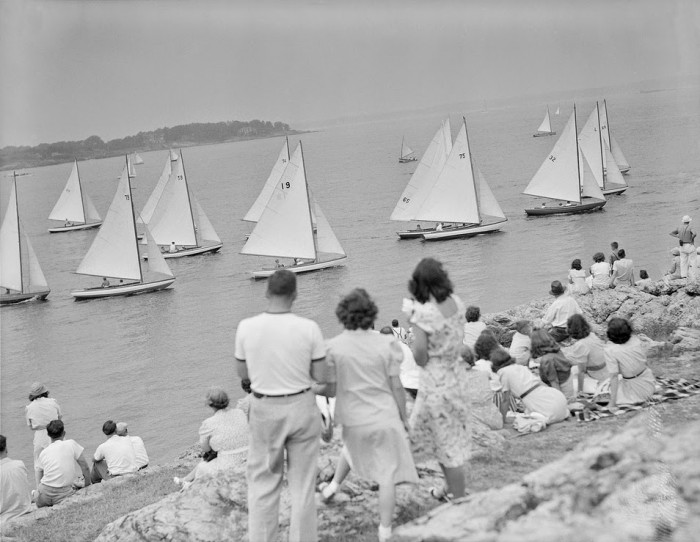
The International 110 was introduced at the 1939 Marblehead Race Week Regatta. Ray Hunt raced the boat around the coarse beating everyone boat for boat except the International One Design. With a price of $480.50 with sails the demand for this vessel began in earnest.

Ray Hunt would forever change the sailing world, hundreds of his new 110 design were being delivered as fast as they could build them. Unheard of for the time period, where other ship yards at best were producing 6-8 yachts a year, there were over 400 hulls built in a two year time period. Today as true testament to Hunt’s abilities, the 110 is still in production, and recently the class celebrated its 75th anniversary in Marblehead, Massachusetts, the place where things all began in those depression years prior to World War II.
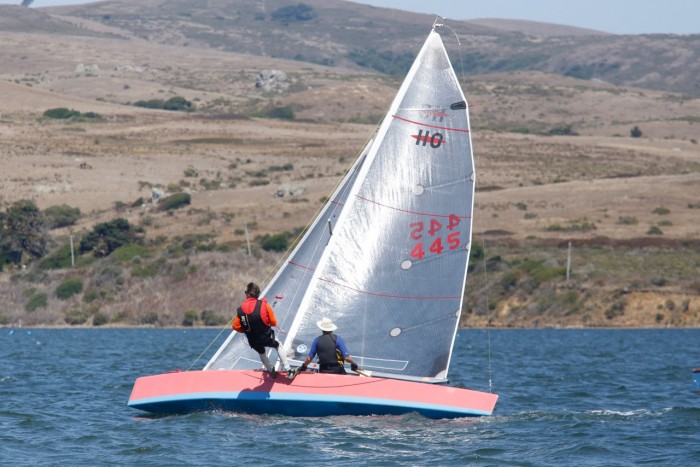
Other innovations that were invented and used first on the Lawley 110 was the trapeze system, and the “Clewouthaul” – which was designed by Bror Tamm in 1939 . The one ten was a radical departure from the yachts of its day, they were unique and iconic in the harbors there were used in. They were the forefathers of today’s ultralight sport boat concept.
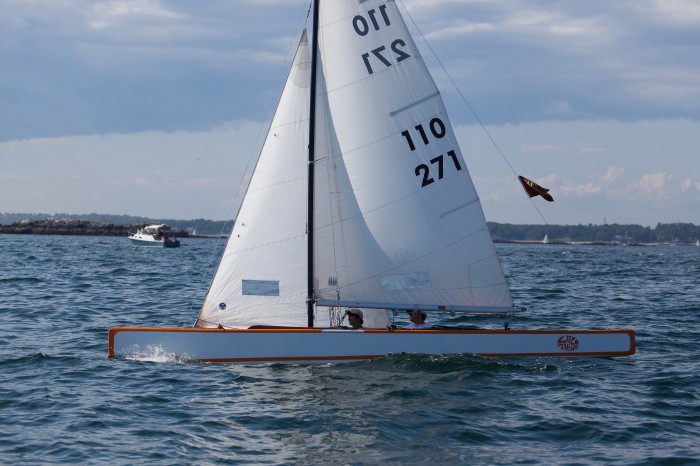
Through the initial aesthetic development of the 110, it was believed that painting the hull in such a way that would accentuate the roundness of the edges was absolutely necessary, if the shape of the hull is to look well. The new painting schedule was encouraged, but was often overlooked, in favor of more budget friendly all in one color paint scheme.
The Internation 110 is still in production, the current builder is Westease Yacht Service, Inc., 66th St & 135th Ave N, Saugatuck, MI 49453, Phone: (616) 394-0076. There are active racing fleets across the US in Maine, Massachusetts, Rhode Island, Connecticut, New Jersey, Illinois, Michigan, California and Hawaii.
International 110 Specifications:
LOA: 24’0” / 7.3m LWL: 18’0″ / 5.5m Beam: 4’0” / 1.2m Draft: 3’0” / 0.91m Displacement: 910 lbs Ballast: 300 lbs Designed: C. Raymond Hunt Hull material: “Harborite” Plywood Construction Original Contract Cost: $480.50 Sail Plan: Main, Jib, Spin Spinnaker: Conventional Upwind sail area: 157 sq ft Spinnaker sail area: 100 sq ft Mast Height: 23’0″ Crew: 2 In production: Yes Class Website: International 110 Class Approximate number built: 750+
THE “TWO-TEN”

The International 210 was drawn by Fenwick Williams, under the guidance of C. Raymond Hunt. Designed to be a bigger drier boat than the 110s. Mr Hunt built a prototype in the Spring of 1946, which was presented to the clubs of Massachusetts Bay for consideration as the selected boat for inter-club racing. The requirements of the clubs were that they wanted a new one design boat that was affordable, pleasant for day sailing as well as racing, a boat that will always be uniform so that it cannot be out-built. ‘Fourth a boat that is modern and can be kept so. At the next meeting, the selection committee announced that Ray Hunt’s proposed “210″ was more boat than any other that the clubs could find for the money, so they adopted it, and with it a new era in yachting was ushered in.

True to the 210s origins through good price, comfort, and exceptional racing abilities, the class took off with some of the sports top sailor’s campaigning boats throughout Massachusetts Bay. Soon fleets were formed throughout the Midwest, Maine, Hawaii and beyond.
Governed by strict one design class rules, to keep boat costs down, but allowing for nominal changes to keep up with the times, a successful concept for the development of the class, yet challenging at times.

The International 210 is currently in production at Shaw Yacht’s, Inc., 52 Oyster River Road, Thomaston, ME 04861, Phone: (207) 594-5035, Fax: (207) 594-5035
International 210 Specifications:
LOA: 29’10” Beam: 5’10” Draft: 3’10” Ballast: 1,175 lbs Displacement: 2300 lbs Designed: C. Raymond Hunt Sail Plan: Main, Jib, Spin Spinnaker: Conventional Upwind sail area: 305 sq ft Spinnaker sail area: Hull material: Double Curvature 3/8 “Harborite” Plywood bent over laminated oak frames. Crew: 3 Original Contract Price: 1,275 – 1,500 w/o sails In Current Production: Yes Class Website: International 210 Approximate number built: 462

THE “THREE-TEN”
As of this writing, not much is known about the 310
THE “FOUR-TEN”

James H. “Sham” Hunt on sailing on the International 410 Et Toi – “CRH and I only..age 13…raced in the New London to Marblehead Race in 1949 and won by such a large margin that the committee called the Canal to see if we had taken a short cut through it..no of course….this was when you had to check in before any transit was allowed! I doubt I added much but he had such stamina that a 24 hour vigil was a piece of cake.”
Thames Yacht Club members considered the International 410 “ Nor’wester ” – “A stylish double-ender, one of the most beautiful boats to ever grace the club fleet. Under sail or bare-poled at her mooring, she always drew comments from people impressed with her near-perfect lines.”
In the Fall of 1961, during the Off Soundings Club Regatta, Nor’Wester’s 4th owner, Charles LaCour and his three member crew were enjoying a comfortable lead with two other boats, they were way ahead of the rest of the fleet. Under full main and small jib with 20-knots of breeze, they were approaching Shagwong Reef buoy off Montauk Point, when a strong squall approached out of nowhere knocking down Nor’wester . A huge swell then filled the non-self-bailing cockpit, and within minutes the boat sunk. The entire crew were picked up and brought to Shelter Island, New York, their final destination point of the first day’s race. That night, still shaken by their ordeal, they returned back to New London, on the Orient Point Ferry.
Anemometer readings, from Montauk Point had clocked gust up to 79 miles per hour. NorWester had sunk in 55′ of water, with strong currents, LaCour decided not to salvage her, figuring reluctantly that they would be unsuccessful in there attempt to raise her.
Later that year, the Off Soundings Race Committee, mandated that all entries had to have self-bailing cockpits. The tragedy influenced the implementation of the Safety of Life at Sea (SOLAS) laws that generated numerous maritime safety rules still in effect today.
Ownership History:
1947 – Et Toi – Ray Hunt 1950s – Nor’wester – Lawrence Chappell, Jr (joined the Thames Yacht Club Fleet) 1950s – Nor’wester – Ray Camp Norwich 1960 – Nor’wester – Charles M. LaCour
Known Racing History:
1952 – Thames Yacht Club Distance Race – First boat to finish and corrected time winner. 1949 – Off Soundings Race – (Lawrence Chappell) Spring and Fall – 1st and 2nd place respectively 1948 New London – Marblehead Race (Ray Hunt) Et Toi beat the nearest competitor by 2 hours.
The 410 “ Nor’wester ” Specifications:
LOA: 35’10 7/8″ LWL: 28’3″ Beam: 6’10 3/4″ Draft: 5’9″ Ballast: Displacement: Designed: C. Raymond Hunt Built By: Marblehead Yacht Yard Year Designed: Year Built: 1947 Sail Area: 482 sq ft Hull material: “Harborite” Plywood Construction Original Owner: Ray Hunt Original Name: Et Toi Sail Plan: Main, Jib, Spin Spinnaker: Conventional Upwind sail area: sq ft Spinnaker sail area: Crew:
THE “FIVE-TEN”
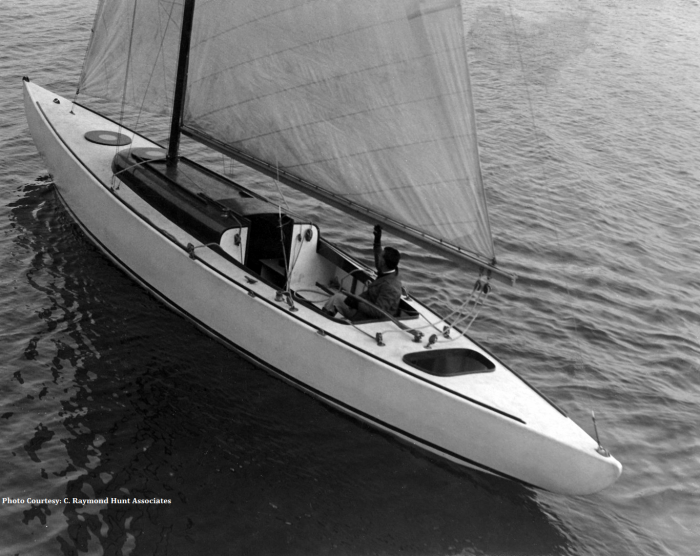
C.Raymond Hunt “In 1945, I designed the original “510” class yacht for myself as a logical development of the “210”.
Launched in December 1945 as a racing and weekend cruising yacht. She is built with no structural keel, and is constructed with two longitudinal trusses on oak floor stiffeners extending to the after end of the cockpit to the mast evenly distributing the stresses of the rig and keel.
Low wetted surface area with a separate rudder-skeg / bulb fin keel, a concept Raymond Hunt embraced long before Lapworth or Giles, should prove to be a spirited performer, with comparable speeds of 8 meters and Q-boats.
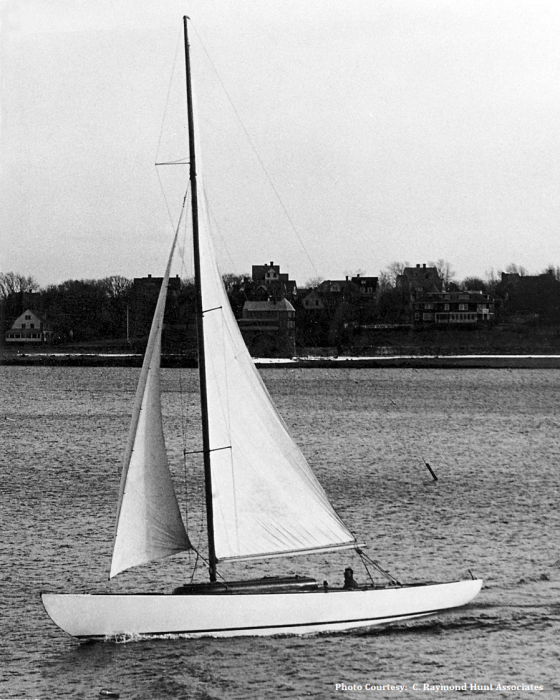
1949 – NYYC Cruise – Beat the 72’0″ Yawl “Bolero” boat for boat, with Raymond Hunt and his wife sailing against a full paid professional crew on board “Bolero”
Historical:
The one and only 510 built, named after Raymond Hunt’s wife Barbara.
Hunt International 510 “Barbara” Specifications:
LOA: 44’7″ / 13.62m LOD: 44’7″ / 13.62m LWL: 32’6″ / 9.93m Beam: 6’7″ / 2.04m Draft: 6′ 0 / 1.82m Ballast: 5,200 lbs Galvanized steel plate/lead casting Displacement: Sail Area: 519 sq ft Yard Number: Hull material: “Harborite” Plywood Construction Rig: Sloop Designer: C. Raymond Hunt Built by: Graves Yacht Yard Year Designed: 1945 Year Built: 1949 Original Contract Cost: $6,000 Restored By: Current Name: Original Owner: C. Raymond Hunt Current Owner: Sail Number: 510/1
International 510 Revisions (March 27, 1975)
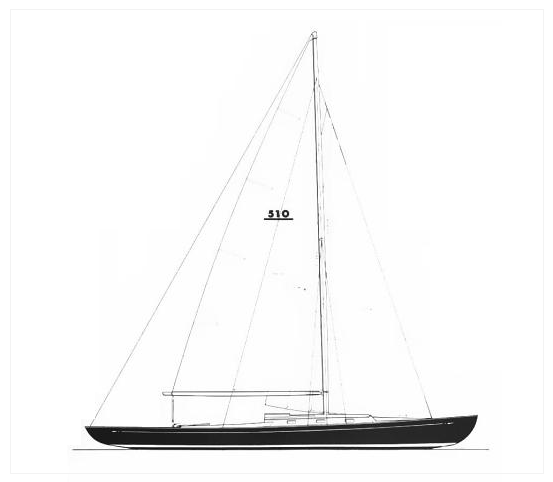
In 1975 C.J. Frankham, esq, Aukland, New Zealand wanted a inexpensive high performance owner operated yacht and decided to have CR Hunt and Associates revise and update the 1945 drawings of the 510 class yacht that Ray Hunt built for himself. The design of the hull was left basically unchanged, but the sailplan was updated. The main was increased 35 sq ft to 335.8′ P = 39.5′ E = 17′ and the jib was increased to measure 215 sq ft I = 37.5′ J = 11.5′ The accommodations were also updated to include 2 berths and settees with a head and small galley located in the companionway for the additional headroom.

Also Modified from the original boat is the deck plan. A self-bailing cockpit replaces the split-cockpit arrangement. The Interior plan, that accommodates 4 people, has been changed to suite the owners requirements.
Although the 510 design was revised for construction to occur in New Zealand, it was never finished. A reported fire in the barn which housed the owners business and the 510 under initial construction were all lost.
Specifications:
LOA: 43’1″ / 13.13m LOD: 43’1″ / 13.13m LWL: 32’6″ / 9.93m Beam: 6’7″ / 2.04m Draft: 6′ 0 / 1.82m Ballast: 5,600 lbs / 2545kg Displacement: 6,900 lbs / 3136kg Sail Area: 551.4 sq ft / 51.2m2 Disp/Length Ratio: 90 SA/Disp Ratio: 24.4 Design Number: CRH – 510 Hull material: “Harborite” Plywood Construction Rig: Sloop Designer: C. Raymond Hunt Associates, 63 Long Wharf, Boston, MA Built by: Year Redesigned: March 27, 1975 Year Built: Never Completed Contract Cost: Restored By: Current Name: Original Owner: C.J. Frankham, esq Current Owner: Sail Number:
International 512 (Company Offered) Revisions (2010?)
LOA: 43’1″ / 13.13m LOD: 43’1″ / 13.13m LWL: 31’11” / 9.48m Beam: 8’0″ / 2.43m Draft: 6′ 0 / 1.82m Ballast: 5,600 lbs Displacement: 6,900 lbs Sail Area: Design Number: Hull material: Rig: Sloop Designer: C. Raymond Hunt Associates For Inquiries: Hunt Yachts Built by: Year Designed: 2010? Year Built: Offered for Spec Contract Cost: Restored By: Current Name: Original Owner: Current Owner: Sail Number:
THE “TEN-TEN”
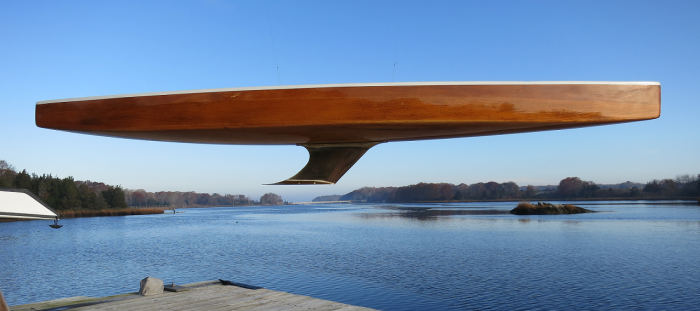
Briggs Swift Cunningham II (January 19, 1907 – July 2, 2003), American sportsman, entrepreneur, and heir to the Proctor & Gamble fortune. Was an accomplished car and yacht racer, having been inducted into the America’s Cup Hall of Fame in 1993, the Motorsports Hall of Fame of America in 1997, and named to the International Motorsports Hall of Fame in 2003. Skipper of the first AC campaigned 12 metre yacht “Columbia” due to Cornelius Shields health concerns. Cunningham and his afterguard won the 1958 America’s Cup race in four straight races off Newport, R.I., each time with a margin of victory of no less than half a mile.
“Mr. C” was an accomplished Star, and 6 metre class sailor, having won numerous races world-wide. By early 1939, having sold Lulu, Fun and Lucie, left Briggs Cunningham without a six-meter for the first time in ten years, at this time Cunningham ordered sailed and raced his C. Raymond Hunt “Lawley 225” out of the Pequot Yacht Club, Southport, Connecticut.
In 1959, through Briggs Cunningham’s long association with C. Raymond Hunt, he decided to have a new yacht designed and tank tested. According to James H. “Sham” Hunt, Mr. Cunningham, “wanted a 110 type boat long enough to beat a 12 meter.” Briggs Cunningham funded the project, “the tank test results came back and said there was too much leeway so the quest ended but later the tank test results (were reevaluated) and said they made an error by not taking into account that the chines on healing gave the necessary force!!!!! the boat would have trounced a 12!”
Hunt designed 1010 Known Specifications:
LOA: 55’0″ / 16.76m Beam: 8’0″ / 2.43m Year Designed: 1959
9″ of bottom curve at mid section
*Note: The keel bulb is missing on the model. Being detachable it allowed CRH to test iterations.
REFERENCES:
James H. “Sham” Hunt (Son of C. Raymond Hunt)
C. Raymond Hunt Associates – Website 1:12 scale 1010 Tank Test Model: Courtesy of James H. “Sham” Hunt Photo credit – James W. Laws Photography Photo credit – A. Mitchell Koppelman Photo credit – Blake Jackson – MarbleheadStudios.com Letters/Brochure – Courtesy of Bill Platt
Related posts:
- C. Raymond Hunt Associates Spirit of Tradition 512 Daysailer
- C. Raymond Hunt – The Lawley 225
- C. Raymond Hunt – The International 510 Class
- C. Raymond Hunt The “TEN-TEN”
Fascinating information on C. Raymond Hunt’s “Ten Series” yachts. What a gift he made to yacht racing and cruising!
Sailed many times aboard 510 Barbara as a child 1950s. My father had bought her from Bob Pierce of Duxbury. Sure would like to know where she is now.
Leave a Comment Cancel
Your email address will not be published. Required fields are marked *
Email Address:
Save my name, email, and website in this browser for the next time I comment.
This site uses Akismet to reduce spam. Learn how your comment data is processed .

Published on July 12th, 2017 | by Editor
International 110: Where Everyone Wins
Published on July 12th, 2017 by Editor -->
by Joe Berkeley As an International 110 pulled up to the hoist at the 33rd Annual Newport Regatta, one design iconoclast Skip Whyte said, “There goes the venerable 110.”
At the age of 78, the 110 has seen a resurgence. There are 26 boats in the Inverness, California fleet where class President Milly Biller has a passion for restoring old boats. With grass roots fundraising efforts, the fleet has bought up old boats and brought them back to life with new plywood bottoms.
According to Milly, restoration is easy. You just remove the bottom, most of the frames, the keelson, and before you know it, you’re sailing again. She said, “This fleet is such a tight group. If I asked anyone for a mast or a boom, I’d probably end up with three.”
In the Midwest, Westease of Holland, Michigan is building new boats from fiberglass. John Huff, a longtime 110’er from Chicago has a new boat on order.

Back East, the International 110 class is a family affair, with most participants having less than one degree of separation from the Craig/Charles family. Tommy Craig has won five National championships with his brother Will, his wife Ann, his son Ben, and his daughter Maggie.
Fleet morale is buoyed by the presence of the Craig’s antique Lyman motorboat, the One Tender which continues to float and run. As an anniversary present, Tom repowered the Lyman for his wife Ann. At the time, he said, “a Lyman is forever.”
The spirit of Tom’s brother Will Craig lives on in the wooden 110 hull he rebuilt. In the early 1980’s, boat #632 was decked out for cruising with two genoas and a hole in the deck where the skipper’s poodle would go up for air. In his spare time, in a small basement, Will rebuilt the boat with Okoume plywood. His workmanship was nothing short of spectacular.
When the new Okoume plywood deck, bottom, and sides was glistening in the sun, a friend asked if it was a new boat. Will said, “No, it’s a retread.” The name stuck and Will is still with the fleet in spirit after he passed away before his time.
At the 110 US National Championship at the Newport Regatta , 15 International 110s with sailors from both coasts vied for bragging rights in Newport, RI. When it was all over, Brad Read quipped at the award’s ceremony, “The double-ended 110 goes forward or backward just as well.” All of the people who love this interesting, quirky, one-of-a-kind Ray Hunt boat went home winners.
To learn more about the 110 class, join the International 110 Class group on Facebook .
Photos : Onne van der Wal.
Joe Berkeley is an amateur sailor and a professional content creator. His work is at joeberkeley.com

Tags: 110 US National Championship , International 110 , Joe Berkeley
Related Posts
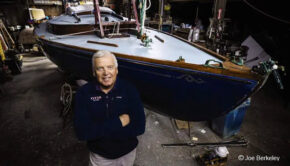
The Magic of Karl’s Boat Shop →
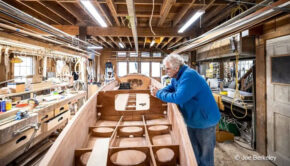
Modernizing the International 110 →
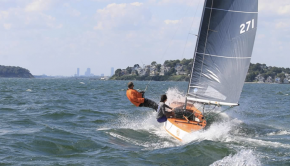
110 Class: A community at work →
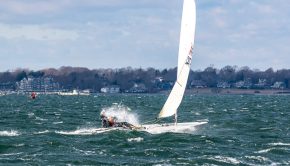
Thriving at 50: It’s all in the family →
© 2024 Scuttlebutt Sailing News. Inbox Communications, Inc. All Rights Reserved. made by VSSL Agency .
- Privacy Statement
- Advertise With Us
Get Your Sailing News Fix!
Your download by email.
- Your Name...
- Your Email... *
- Name This field is for validation purposes and should be left unchanged.

Performance
Accomodation.
Report error
Tell us what's wrong
We do our best to fix any errors in boatpedia. thanks for the help.
- New Sailboats
- Sailboats 21-30ft
- Sailboats 31-35ft
- Sailboats 36-40ft
- Sailboats Over 40ft
- Sailboats Under 21feet
- used_sailboats
- Apps and Computer Programs
- Communications
- Fishfinders
- Handheld Electronics
- Plotters MFDS Rradar
- Wind, Speed & Depth Instruments
- Anchoring Mooring
- Running Rigging
- Sails Canvas
- Standing Rigging
- Diesel Engines
- Off Grid Energy
- Cleaning Waxing
- DIY Projects
- Repair, Tools & Materials
- Spare Parts
- Tools & Gadgets
- Cabin Comfort
- Ventilation
- Footwear Apparel
- Foul Weather Gear
- Mailport & PS Advisor
- Inside Practical Sailor Blog
- Activate My Web Access
- Reset Password
- Customer Service

- Free Newsletter

Blue Jacket 40 Used Boat Review

Catalina 270 vs. The Beneteau First 265 Used Boat Match-Up

Ericson 41 Used Boat Review

Mason 33 Used Boat Review

How to Create a Bullet-Proof VHF/SSB Backup

Tips From A First “Sail” on the ICW

Tillerpilot Tips and Safety Cautions

Best Crimpers and Strippers for Fixing Marine Electrical Connectors

Polyester vs. Nylon Rode

Getting the Most Out of Older Sails

How (Not) to Tie Your Boat to a Dock

Stopping Mainsheet Twist

Fuel Lift Pump: Easy DIY Diesel Fuel System Diagnostic and Repair

Ensuring Safe Shorepower

Sinking? Check Your Stuffing Box

What Do You Do With Old Fiberglass Boats?

Boat Repairs for the Technically Illiterate


Boat Maintenance for the Technically Illiterate

Whats the Best Way to Restore Clear Plastic Windows?

Stopping Holding-tank Odors

Giving Bugs the Big Goodbye

Galley Gadgets for the Cruising Sailor

The Rain Catcher’s Guide

Sailing Gear for Kids

What’s the Best Sunscreen?

UV Clothing: Is It Worth the Hype?

Preparing Yourself for Solo Sailing

R. Tucker Thompson Tall Ship Youth Voyage

On Watch: This 60-Year-Old Hinckley Pilot 35 is Also a Working…

On Watch: America’s Cup

On Watch: All Eyes on Europe Sail Racing

Dear Readers
- Sailboat Reviews
C&C Express 110
The first new c&c since the acquisition of the c&c name by tartan, the 110 is available with a surprising number of keel and rigging choices. she’s fast and fun to sail, but as a cruiser her stowage comes up short..
The Fairport Marine Company of Fairport Harbor, Ohio was organized by a group of investors to rescue Tartan Yachts when it suffered the financial vagaries of the boatbuilding industry during the early 1990s. Tartan was reorganized under the direction of general manager and chief designer Tim Jackett. It is one of the last few production builders to construct built-up wooden interiors rather than use fiberglass pans.
The company has doubled its plant size in the last three years, increased the number of employees from 38 to 130, and is building 90-100 boats per year. Russ Byrnes, who was plant manager of Tartan during the 1980s, returned to reassume that position and two full-time employees have been hired in customer service. The company now has 21 dealers located in most major sailing areas.
Following a fire that ruined the company’s molds and several boats under construction, C&C, the long-time Canadian builder, fell on hard financial times in the early 1990s. Its assets were purchased by a group of Hong Kong investors intent on building sailboats and powerboats, but that venture failed.
Jackett describes the 1997 acquisition of C&C’s name and assets as an opportunity to take advantage of C&C’s reputation for building performance-oriented boats. The company purchased the engineering library and equipment necessary to provide customer service for a loyal following of owners, some of whom may be in the market for new boats.
Part of C&C’s inventory included the hull and deck mold for a 52-foot cruiser that may be offered as a semi-custom boat and companion to the Tartan 46-footer. A 32-footer, the C&C 99, and the 40-foot C&C 121, both designed by Jackett, round out the current line.
Design Introduced in 1998, the C&C 110 replaced the 34R, a misnamed 36-footer that was sold as a performance cruiser capable of J/35 speed.
“But it didn’t have the speed,” Jackett said.
The new 110 is 36′ 4″ with a 31′ 6″ waterline.
“Our objective was to come up with a totally new design because the old boat was 10 years old, and we didn’t think the market would be excited about an old boat.”
After inspecting blueprints and a fleet of used C&C’s, he started from scratch to create a design similar to her predecessors.
The boat features the same flat sheer line and deck camber that defined C&C products. The hull has a finer entry than its predecessors, and the run aft is flatter. The moderate deadrise produces a stiffer form that is less prone to heeling. Freeboard is slightly greater in response to a perceived need for large interior volume.
Underwater, the keels are high-lift, low-drag sections with a bulb tip to lower the center of gravity and increase stability. They were “optimized” at NASA’s Lewis Space Center. Three keels, with drafts ranging from 4′ 10″ to 7′ 3″, are available.
Thirty-five Express 110’s have been built to date.
Construction “In order to improve performance, we had to control weight more than we do with Tartan Yachts,” Jackett said.
To that end, the lamination schedule includes the use of vinylester resin throughout and vacuum-bagging. Vinylester is most noted for its blister-resistant properties, but Jackett said it also is 10% lighter than conventional polyester resins.
The company has been using vinylester since the 1986 Tartans were introduced, and claims its boats have been blister-free since.
“Part of the reason is the quality of the gelcoat we use, and part is timing. We spray gelcoat in the morning so we can apply the skin coat within eight hours, which creates a better physical and chemical bond.”
Light, bi-directional E-glass and Kevlar are employed in the lay-up. Kevlar strips run the length of the boat on the centerline, and athwartships from gunwale to gunwale to add reinforcement for the chainplate areas.
The entire hull and deck is cored with Core-Cell structural linear foam that meets ABS requirements and is Lloyds approved.
“We use that product in lieu of end-grain balsa because it is lighter, though not as stiff, and has better impact resistance,” Jackett said. It’s the “bends but doesn’t break” theory.
To offset the difference in impact resistance, 5/8″ CoreCell is used in areas that would otherwise be constructed of 7/16″ balsa.
Unlike the Tartans, the C&C 110 has a fiberglass interior pan. It is bonded to the hull with Core-Bond adhesive that is supposed to eliminate voids that could fill with water.
Bulkheads are bonded to the hull with Plexis 320 adhesive rather than fiberglass tabs because, Jackett said, “glass will pull off the hull under 1,200-1,500 pounds of pressure, but the adhesive withstands loads of 1,700-2,000 pounds.”
“The hull-deck joint follows the same design we’ve used for 25 years,” Jackett said.
The deck overlays a flange on the hull between which is sandwiched an aluminum bar, all of which are bonded with 3M 5200 and fastened with 1/4″ stainless steel fasteners on 9″ centers. Because the fasteners are tapped into predrilled holes in the aluminum there’s no need for locking nuts, and they are removable.
Cabinetry belowdecks is constructed of cored fiberglass panels covered with varnished cherry. Compared to the Tartan 3500, Jackett said that he’s reduced cabinet weight by 40-50 pounds. From an aesthetic standpoint, you can’t tell the difference.
Access to wiring runs, which are color coded and located in PVC conduit running along the hull, is excellent. Cutouts in the PVC where wires are led to fixtures make repairs easier.
The same holds true for plumbing fixtures, hoses and through-hulls, all of which are easily accessible below floorboards and in cabinets.
Deck Plan Though the boat has been designed for the cruising sailor, its deck layout incorporates features typically found on race boats. Also, halyard and mainsail control lines are led aft underneath fiberglass covers. We like this setup for two reasons: it eases sail handling and removes toe-stubbing clutter.
The triple-spreader mast is made by Offshore Spars with an Awlgrip finish. Navtec rod rigging is standard equipment. Inside the boom, also constructed by Offshore, is a 4:1 outhaul and reef line. The boom is internally stiffened for a vang lug.
One of the most interesting differences between the 110 and its competitors is the choice of spinnaker setups. One may fly a conventional spinnaker from the masthead, though the spinnaker pole is 16′ long and will be penalized 3-6 seconds when racing under PHRF. The payoff should be increased downwind performance at low sailing angles.
As an alternative, the boat may be ordered with a carbon fiber sprit that retracts into a tube that extends from the bow to inside the forward stateroom; it’s the same setup popularized on some of the J-Boats. We think this is an excellent option because it allows couples to fly large sails downwind without the hassle or stress associated with a conventional pole, topping lift and fore and after guys. The additional sail area will greatly improve downwind speed, and dousing an asymmetrical can be as simple as furling a 150% genoa.
The downside of sprits is that to get the extra speed you must sail higher jibe angles, thus covering more distance.
Jackett said that about 50% of the boats are equipped with sprits.
We also like the fact that the drum of the Furlex 200S furler is recessed below deck level, out of the way when anchoring or picking up a mooring buoy. And, because the bow pulpit is 24″ forward of the headstay, working the foredeck is quite manageable.
To keep the decks clear of unnecessary lines and clutter, PVC tubes are glassed against the inside of the hull, in which run the lines for controlling the furler (which exits near the helmsman’s left foot), and for the sprit.
The self-draining anchor locker is large enough for a 35-lb. anchor and adequate rode. One owner, however, discovered a leak between the locker and hull, which resulted in water draining into the bilge. The area was reglassed by his dealer, but that’s an area we’d examine closely.
All of the deck gear, including hatches, winches, rope clutches, blocks, stanchions and stanchion bases are made by Lewmar. Ventilation and light are provided by five, smoke gray acrylic Ocean and Coastline series hatches. The hatch over the forepeak measures 24″ x 24″, a second at the mast measures 16″ x 18″, a third over the saloon is 12″ x 17″, and 10″ x 10″ hatches are over both galley and head.
Primary winches are Ocean Series Lewmar 42 self-tailers. Secondaries are 40STs, and 30STs are on the coachroof for halyards, mainsail controls, and vang. Two pairs of rope clutches are mounted on each side of the cabintop.
The mainsheet arrangement presents potential owners with three options. The standard traveler is mounted atop the coachroof and the mainsheet is led forward to the base of the mast, then back to a sheet stopper.
Alternatively, a 48″ traveler can be mounted on the bridgedeck aft of the companionway. This will give better boom control when coupled with an optional vang. The downside is a sheet located directly in front of the companionway.
For single-handed sailors, the traveler can also be located immediately forward of the pedestal steerer. When coupled with rope clutches on the coaming directly in front of the primary winches, a solo or shorthanded sailor will have all sail controls within reaching distance of the helm. One owner told PS that the arrangement works well.
Except for a pair of short stainless steel handrails running from forward of the companionway to the mast, the deck is remarkably free of clutter. The 20″ sidedecks and 24″ double lifelines make movement about the boat easy and safe.
The cockpit handles six passengers comfortably. Seats are 60″ long and 19″ deep. The 15″ seatbacks are contoured. Knee support is 14″ from the cockpit sole and a footbrace has been molded into the sole to provide support while beating—a nice touch.
The standard wheel is a 48″ Edson, which will suit most buyers; our test boat had an optional 55″ wheel that we appreciated when seated on the rail watching telltales on the genoa.
Under the direction of Rob Ball (who used to work as a designer for C&C), Edson has designed a pedestal, instrument pod and rack and pinion steering system for the 110.
The primary shortcoming of the cockpit is a lack of stowage, because of the location of the engine and stateroom below the cockpit.
Lazarettes in the stern are 45″ deep and run the width of the boat, but they are so narrow that access is difficult. Inside are the batteries, hot water tank, inverter, refrigeration unit and 16-gal. holding tank; maintenance chores in this area will be most easily performed by a person of Lilliputian stature.
One owner fashioned a group of mesh bags that he attached to the hull inside the lazarette and organized several plastic containers for storage of fenders, cleaning gear and a small liferaft. Solving the stowage problem is possible, but challenging.
Jackett’s approach to the design of a swim platform is one of the most innovative we’ve seen on a sailboat, a concept we’d guess has it origins in European power boats.
The swim platform is inset flush to the stern in a watertight cavity that is almost unnoticeable. By switching on a HatchMaster electric motor, the 24″ x 36″ platform swings out and down, anchored by stainless steel wires connected to the hull. A three-section stainless steel ladder attached to the aft end of the platform then telescopes downward to allow easy access from the water. It’s a mechanical and cosmetic masterstroke.
Interior The accommodations plan is conventional, but we like the combinations of wood, smooth gelcoat and chrome accents. Headroom is 72″.
The galley is to starboard at the foot of the companionway, opposite the head and nav station. A dining table is located in the center of the saloon with hinged 42″ x 18″ leaves that, when elevated, provide seating for four adults on the 25″-wide settees.
The port settee is 81″ long, the starboard 68″. If outfitted with lee cloths, they can double as sea berths. Outboard of the settees are small storage areas, but most of the space below them is occupied by an aluminum 70-gal. water tank and 26-gal. fuel tank. A second water tank is located beneath the V- berth in the bow.
Tanks are secured to the hull with 1″ wide aluminum straps secured in solid wood beds.
The nav station is located to port at the aft end of the settee and displays another of Jackett’s innovations; a double-railed stainless steel backrest hinged to the cabinet swings inboard to provide the navigator with a backrest when seated on the settee. The chart table is 33″ x 19″ deep, and has cabinetry large enough for a full range of instruments.
The galley is fully equipped but small. The double stainless steel sinks are only 12″ x 10″ and the ice box is really only useful for weekenders. There is some stowage in three cabinets outboard of the Force 10 two-burner stove and oven.
By comparison, the head is uncharacteristically large for a 36-footer. The main compartment is 45″ x 28″, and is equipped with a 12″ stainless steel sink, Jabsco toilet, a small counter space and two storage compartments.
The 22″ x 44″ shower stall is located behind clear Plexiglas panels and is equipped with a seat and modern Scandvik fixtures.
The V-berth measures 80″ on the centerline, is 76″ wide and has 26″ of space at the foot. Stowage below the berth is in wire baskets. The stateroom has a hanging locker and a closet with three shelves.
The aft cabin is in the starboard quarter and has an athwartships double berth measuring 80″ x 60″. It is ventilated by two portlights. A hanging locker and small counter round out the accommodations. Considering its size, location below the cockpit, and intrusion by the aft end of the engine box, it is a “minimum” double berth.
As with the cockpit, the major shortcoming is the lack of stowage space for cruising. And for racers, a full inventory of sails will spill over into living areas such as the shower and aft cabin.
Performance Jackett’s polar predictions indicate that the boat’s best upwind performance will be 7.25 knots in 20 knots of wind sailing 36°-38° off true wind. Downwind performance is best at 20 knots of wind sailing at 135° off true wind, when she’ll hit more than 10 knots. Polars, of course, tend to be optimistic.
Following the launch of hull #1 in San Francisco, Jackett reported speeds of 6.7 to 7 knots in 8 to 12-knot winds. When the breeze increased to 16 knots, boat speed reached 7.8 knots.
We tested the boat on Lake Michigan on a breezy day in very lumpy conditions created by a northwesterly that blew through the previous evening. Unfortunately, after sailing for an hour in 14 knots of true wind with a 135% genoa it became obvious that the boat’s instruments required calibration because speeds never exceeded 5.5 knots.
If you’re not used to helming a lightweight, sporty boat with a narrow keel, the 110 might take some getting used to before you can consistently steer a straight line. Nevertheless, the boat tacked smoothly and quickly and accelerated quickly. In what could have been uncomfortable conditions, we were impressed with her buoyancy in a close, 2′-4’ chop, and its ability to knife through waves without hobbyhorsing. She’s also dry.
Under power, the 28-hp. Volvo Penta MD2030 powered the boat at 6.5 knots at 2,800 rpm.
Owner John Dodge, who sails his boat on Lake Michigan, told us he’s a performance sailor who previously raced a Hobie and S.2.
“I sail shorthanded, primarily, and wanted a clutter-free cockpit for days when the grandchildren are aboard,” he said regarding his choice of the singlehander’s sheeting configuration. “The conduit system, with lines led to the winches, is very efficient.”
“The boat sails 6.5-7 knots in less than 20 knots of wind. In 25 knots we sail under the genoa at 8 knots on a broad reach. She heels to 15-20°, then stops,” he said.
Rich Bergman, a veteran racer in San Francisco, purchased the sprit model as a multi-purpose family boat.
“I like this boat because it’s dry, doesn’t heel dramatically, and has better creature comforts than a J/105, though I don’t think it points as high as the J-Boat,” he said. Still working to maximize performance, he’s recorded several mid-fleet finishes in a local PHRF fleet.
“On a typical weekend, I’ll race the boat, then be joined by my wife and daughters for a cruise and dinner aboard.”
Warranty Fairport Marine’s warranty provides coverage of the boat and all parts manufactured by Fairport for 12 months from delivery; additional coverage for chainplates, mast step and floor timbers is extended to 10 years.
Below-the-water gelcoat surfaces are warranted to be free from osmotic blistering for 10 years from the date of delivery, to the original purchaser.
Based on our recent review of the industry’s practices (PS July 1, 1999), C&C’s warranty is as good (or bad) as its major competitors.
Conclusions Jackett and Company have designed and built a boat that should have wide appeal. She meets the requirements of a casual cruiser and dedicated racer. Its projected PHRF rating of 72 will be subject to revision if the 110 fares too well on the race course.
We especially like the optional sprit arrangement, which allows both full and shorthanded crews to fly asymmetrical spinnakers, thereby sailing to her potential.
Creature comforts are well thought out, though short on stowage both in the cockpit and below.
Base price of the boat is $137,500, to which cruisers should add approximately $7,000 for refrigeration, inverter, microwave, entertainment center and other amenities. Racers will add approximately $11,000 for spinnaker gear, adjustable genoa tracks, rigid vang and a hydraulic backstay adjuster.
Stock boats are equipped with a Dacron full-batten mainsail and 135% genoa, which will be adequate for cruisers but racers should add the cost of high performance sails.
Contact- C&C Yachts, Fairport Marine Co., 1920 Fairport Nursery Rd., Fairport Harbor, Ohio; 440/354-3111.
RELATED ARTICLES MORE FROM AUTHOR
Leave a reply cancel reply.
Log in to leave a comment
Latest Videos

Cabo Rico 34 Boat Review

Super Shallow Draft Sailboat: The Leeboard Sharpie

Hans Christian 41T – Boat Review

Seven dead after superyacht sinks off Sicily. Was the crew at...
Latest sailboat review.

- Privacy Policy
- Do Not Sell My Personal Information
- Online Account Activation
- Privacy Manager

110′ Yachts for Sale
Find the perfect 110 feet yachts for sale.
Our website features plenty of 110′ superyachts all around the world, discover the perfect yacht closer to you!
Explore the pinnacle of luxury yachting with FGI Yacht Group’s exclusive collection of 110′ yachts for sale. These resplendent vessels represent the ultimate confluence of elegance, innovation, and nautical mastery. Exquisitely crafted to meet the discerning demands of our esteemed clientele, our 110-foot yachts exude sophistication and unparalleled grandeur. With palatial interiors, technologically advanced amenities, and robust performance capabilities, each yacht is a testament to the fine art of maritime craftsmanship. The 110′ category invites you to indulge in a realm where every detail is meticulously curated to create a transcendent experience on the open sea. Allow FGI Yacht Group to expertly navigate you towards a 110′ yacht that embodies your vision of luxury and seamlessly elevates your seafaring adventures.

JOHNSON 115 SKYLOUNGE W/FB

2026 INACE EXPLORA 115

WIRE WE HERE

DIONYSOS 35
Contact broker, would you like us to call you back.
Your Name Your phone number Best time to call

Great choice! Your favorites are temporarily saved for this session. Sign in to save them permanently, access them on any device, and receive relevant alerts.
- Sailboat Guide

1960 Internation 110
- Description
Seller's Description
International 110
1960’s Jesiek Bros. built. First sold in 1974.
2021 replaced keel sump with G10 backing
2021 replaced aft deck
2021 new deck hardware
2021 barrier cote
2021 bottom paint
spinnaker pole
1 mainsail (serviceable)
1 jib (serviceable)
Sails purchase from #16
1 light main
1 heavy main
1 light genoa
1 heavy genoa
1 spinnaker
one spinnaker
Sorry for the poor resolution in the photo. I have many high resolution photos available that are too big to upload to SA.
This listing is presented by SailingAnarchy.com . Visit their website for more information or to contact the seller.
View on SailingAnarchy.com
Embed this page on your own website by copying and pasting this code.
- About Sailboat Guide
©2024 Sea Time Tech, LLC
This site is protected by reCAPTCHA and the Google Privacy Policy and Terms of Service apply.


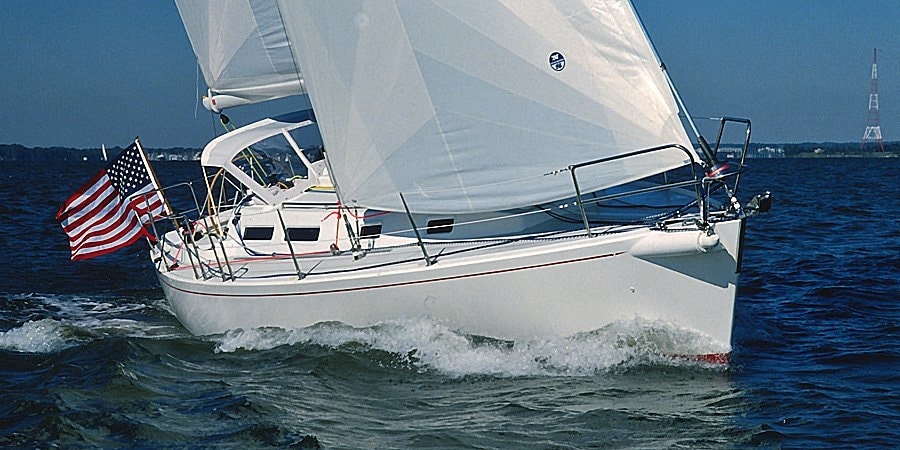









COMMENTS
The International 110 is an American sailboat that was designed by C. Raymond Hunt as a one-design racer and first built in 1939. [1][2][3] While most boat designs have numerical designations that reflect their length overall, waterline length, displacement or some other dimensional parameter, the 110 class was named for the sail number that ...
Inverness YC hosted the 82nd International 110 National Championship regatta on Tomales Bay August8-12. With the largest 110 fleet in the US, IYC hosts the regatta every three years.Twenty boats competed in this year's regatta, including two father-son teams from the recentlyformed fleet on Bainbridge Island, WA; two more family teams from Hull YC outside…
A boat with a BN of 1.6 or greater is a boat that will be reefed often in offshore cruising. Derek Harvey, "Multihulls for Cruising and Racing", International Marine, Camden, Maine, 1991, states that a BN of 1 is generally accepted as the dividing line between so-called slow and fast multihulls.
The Internation 110 is still in production, the current builder is Westease Yacht Service, Inc., 66th St & 135th Ave N, Saugatuck, MI 49453, Phone: (616) 394-0076. There are active racing fleets across the US in Maine, Massachusetts, Rhode Island, Connecticut, New Jersey, Illinois, Michigan, California and Hawaii. International 110 Specifications:
April 11, 2023. Master boatbuilder Steve Clark's latest creation is a kit-build, class-legal International 110, which he started with a 3D scan and built in his boat barn in Rhode Island. Joe ...
About International 110. Designed by legendary yachtsman, yacht designer and sailing Hall of Fame member C. Raymond Hunt, the International 110 is an extraordinary boat. 24′ long, 4′ wide and weighing only 910 lbs, this double-ended, flat bottomed, slab-sided planing boat is extraordinarily fun and fast in all directions.
C. Raymond Hunt, and internationally known and respected helmsman and yacht designer. A gifted visionary, with an innate sense of the physics of motion. To his peers he was a man "ahead of his time" To his competitors, through his creation of the deep-V hull, and the radical international 110, the preeminent forefather of … Read more "C. Raymond Hunt's "TEN" Series (110-210-310-410 ...
John Huff, a longtime 110'er from Chicago has a new boat on order. Back East, the International 110 class is a family affair, with most participants having less than one degree of separation ...
110 is a 24′ 0″ / 7.3 m monohull sailboat designed by Raymond Hunt (C.R. Hunt & Assoc.) and built by Schock W.D., Lawley (George Lawley & Son), Graves Yacht Yard, and Cape Cod Shipbuilding starting in 1939. ... The higher a boat's D/L ratio, the more easily it will carry a load and the more comfortable its motion will be. The lower a boat ...
The 110 sailing boat is a small, one-design racing sailboat that was designed by the American naval architect, William F. Crosby, in the 1930s. It was originally built as a wooden boat, but later versions have been constructed using fiberglass. The 110 sailing boat measures approximately 36 feet in length and has a beam of around 6 feet.
110 Class 1989 Handbook. 110er John Burton was kind enough to scan and distribute the classic 1989 110 class yearbook. It's an extensive tome with lots of great history, lore, advice, humor and tips. It's a great read for anyone interested in 110's, and features some great names associated with this wonderful class of sailboats. Check it ...
A 32-footer, the C&C 99, and the 40-foot C&C 121, both designed by Jackett, round out the current line. Design. Introduced in 1998, the C&C 110 replaced the 34R, a misnamed 36-footer that was sold as a performance cruiser capable of J/35 speed. "But it didn't have the speed," Jackett said.
Called the 110 EXPRESS when first introduced. Draft=4.83'/1.32m Disp.=11200 lbs. /5080 kgs. Ballast=4500 lbs./2041 kgs. In 2001 a redesigned 'High Performance' keel: (DRAFT 6.50'/1.981m) became standard and the deep keel option was dropped. The standard rig was a triple spreader Offshore Spars rig with rod rigging.
Find Sail C-c 110 boats for sale in your area & across the world on YachtWorld. Offering the best selection of c-c boats to choose from.
Find the perfect 110 Feet Yachts for Sale . Our website features plenty of 110′ superyachts all around the world, discover the perfect yacht closer to you! Explore the pinnacle of luxury yachting with FGI Yacht Group's exclusive collection of 110′ yachts for sale.
The International 110, often just called the 110 is a one-design racing sailboat designed in 1939 by C. Raymond Hunt. People familiar with 110's don't understand why people think the concept of...
2022 National Regatta Results. Inverness YC hosted the 82nd International 110 National Championship regatta on Tomales Bay August8-12. With the largest 110 fleet in the US, IYC hosts the regatta every three years.Twenty boats competed in this year's regatta, including two father-son teams from the recentlyformed fleet on Bainbridge Island, WA ...
Expired. $4,999 USD. Seller's Description. International 110. 1960's Jesiek Bros. built. First sold in 1974. 2021 replaced keel sump with G10 backing. 2021 replaced aft deck. 2021 new deck hardware.
110 preowned sailboats for sale by owner. 110 used sailboats for sale by owner. Home. Register & Post. View All Sailboats. Search. Avoid Fraud. ... Featured Sailboats (all): 28' Morgan Out Island 28 Palmetto, Florida Asking $14,500. 46' Morgan 45 Davis Islands Yacht Club, Florida Asking $22,500. 13' Laser dinghy
J/110. Save to Favorites . Beta Marine. BOTH. US IMPERIAL. METRIC. Sailboat Specifications Definitions ... 1997), states that a boat with a BN of less than 1.3 will be slow in light winds. A boat with a BN of 1.6 or greater is a boat that will be reefed often in offshore cruising. Derek Harvey, "Multihulls for Cruising and Racing ...
The "C&C 110 Owners" group was set up as a means for like minded sailboat owners who wish to share, learn and network with other C&C 110 owners. It's a place to share ideas about improvements and...
Steering was sweet and responsive with ideal feedback. In short, the J/110 is a very likable 36-footer. She sails virtually to her numbers, which means that given Disp/Length of 190 she remains light, quick to accelerate and spry, and given SA/Disp of 19.9 she retains good horsepower without an intimidating sail plan.
The boat was built by C&C Yachts in the United States, but it is now out of production. The C&C 110 is a small recreational keelboat, built predominantly of fiberglass. It has a masthead sloop rig, an internally-mounted spade-type rudder and a fixed fin keel. It displaces 10,900 lb (4,944 kg) and carries 4,200 lb (1,905 kg) of lead ballast.
Make waves with this adventurous boat-shaped diamond necklace. Sterling silver Round-cut diamonds Total diamond weight is 1/10 carat 16- to 18-inch adjustable cable chain with lobster clasp Skip to Content Skip to Navigation. Save 20-40% Off* Everything! Shop All Deals. Shop All Deals > 1-800-527-8029 ...